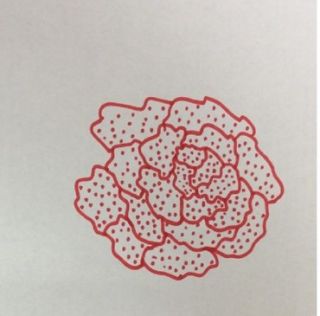
Collectors of art buy art directly from artists, an intermediary representing an artist, or on the secondary market. Often, within this process, collectors become interested in the artist who created the art they buy and what makes that artist tick.
To put it differently, some collectors aspire to understand why artists do what they do, and conversely, some artists desire to understand collectors and why they buy what they buy. This can create a richer experience for both. Here, we explore one facet of this puzzle: artists’ involuntary thoughts related to specific visual tasks.
The Research

Example of doodling using a circle
Source: Courtesy of Creative Commons
Kaimal et al. (2017) studied how three creative self-expression tasks—coloring, doodling, and free drawing—activate the brain’s medial prefrontal cortex (mPFC) and reward pathways. Using fNIRS (Functional near-infrared Spectroscopy), both portable and non-invasive, brain activity can be measured. A cap with small probes is placed on the participant’s head, and the probes shine infrared light into the scalp. The probes also detect how much light passes through. fNIRS measures changes in blood flow in the brain, which indicates how much a particular part of the brain is being used.
%20Location%20of%20functional%20near%20infrared-spectroscopy%20optodes%20on%20the%20prefrontal%20cortex%20(Ayaz%20et%20al.,%202012).%20(b)%20Setup%20of%20the%20study%20with%20the%20functional%20near-infrared%20spe.jpeg.jpg?itok=2rd3Vloj)
Location of functional near infrared-spectroscopy optodes on the prefrontal cortex
Source: Courtesy of Creative Commons
Using this technique, the researchers found that all three conditions (coloring, doodling, and free drawing) activated the mPFC and reward pathways significantly more than the rest conditions. Doodling showed the highest activation, although the differences were not statistically significant. The authors’ interpretation was that art making, even in short sessions, can evoke positive neural responses associated with reward and emotional regulation.
A Personal Story
A member of our family has been doodling since she was four or five years old. At first, her spontaneous drawings were unsophisticated, as one would expect at a tender age. As time has passed, however, they have become complex and remarkedly appealing.
I always thought this young lady doodled to pass the time. It was something to engage in when she wasn’t involved in other activities. Now, I know that though that may be true, she also was receiving pleasure from her pastime. Therefore, she continues to do it even though she is now an adult and regularly sells the art she produces.
Conclusion
%20for%20each%20condition..jpeg.jpg?itok=sYIoF65c)
Levels of oxygenation (activation of the medial prefrontal cortex) for each condition.
Source: Courtesy of Creative Commons
Visual self-expression, whether through coloring, doodling, or free drawing, is more than just a pastime—it activates reward pathways in the brain, providing emotional satisfaction and pleasure. The research by Kaimal et al. (2017) underscores how even simple forms of art making can evoke significant positive neural responses, highlighting the intrinsic value of creative activities. Collectors and artists may find a more profound appreciation in understanding these processes; for artists, creating brings personal fulfillment, while collectors gain insight into the profound emotional motivations behind each piece of work. Acknowledging the shared human desire for emotional expression and reward can cultivate a richer, more rewarding connection between creators and collectors alike.








